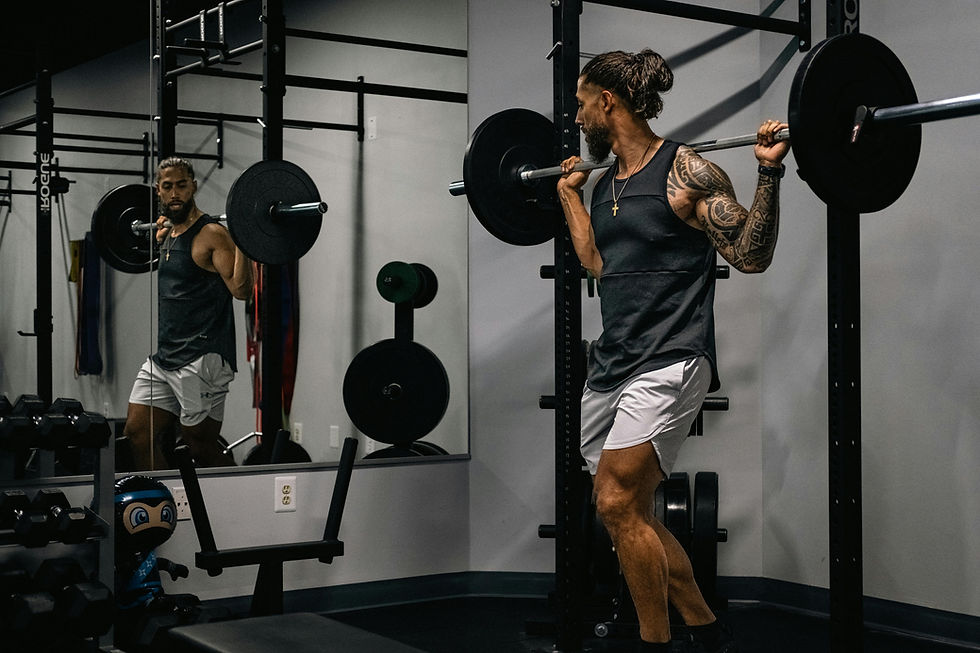How do I warm up for a workout?
- RedPrint Fitness
- 2 days ago
- 3 min read
What is the best way to warm up for a workout? Cardio? Stretching? Mobility Drills?
When starting out in the gym, warming up is either ignored completely or overdone to the point of hindering the workout. Warm-ups are essential for optimal performance and safety, but the necessities of a complete warm-up are often hard to find or fragmented, leading some lifters to skip straight to their working sets.

Warming-Up for Performance
By increasing your heart rate and getting your blood pumping your body is primed to deliver oxygen and nutrients to the muscles. The light warm-up also acts as a dynamic stretch, preparing the joints and muscles to move smoothly through their range of motion.
Skipping straight to an all out set without a warm-up increases your risk of muscle strains and can put a high demand on your heart to immediately begin circulating blood, potentially leading to irregular heartbeats. The combination of blood flow and slight stretching allows the muscles to contract effectively and efficiently when higher demand is placed on them.
What does a simple warm-up look like?
Like all aspects of fitness warm-ups should be specific to the individual. Some lifters may only need a couple warm-up movements before starting their working sets. Others may need additional stretching or activation drills to feel primed and ready to lift. Incorporate any stretches or mobility drills that you find reduce pain or strain into your warm-up to make sure you feel fully prepared.
The goal of the warm-up is to increase your heart rate and blood flow to make sure your muscles will get the necessary oxygen and nutrients during the workout. The warm-up shouldn’t be taken close to failure to avoid fatigue, so keep several reps in reserve for each warm-up set.
To keep it simple, lets go over a simple warm-up routine that can be applied before any workout.
Sample Warm-Up
General
Treadmill (or alternate cardio option) 5-10 minutes
Movement Specific
2 Lightweight Sets of the muscle group(s) you’re training
Pyramid to Working Weight
Several sets of increasing weight (avoid failure)
Ex. Chest Day Warm-Up (Bench Press)
General
Incline Treadmill - 8 minutes
Movement Specific
Dumbbell Lateral Raise – 2 sets of 15
Pyramid to Working Weight
1st Exercise: Bench Press (Working weight 225)
Warmup 1: 5 Reps @ 45lb (empty barbell)
Warmup 2: 5 Reps @ 110lbs
Warmup 3: 3 Reps @ 155lbs
Warmup 4: 2 Reps @ 200lbs
Working Set 1: 5 Reps @ 225lbs
Using a lightweight to warm up the movement specifically primes the muscles for the heavy sets and allows you to prepare mentally by practicing the movement. Additionally, these sets allow you to self-assess how you are feeling before picking a challenging weight.
If you feel pain during the warm-up sets, you can avoid injury by lowering the working set weight or selecting an alternate exercise. Do as many warm-up sets as you need to feel confident and comfortable performing the movement, but 2-4 sets is a good range to prepare for a heavier lift.
Pyramiding up to your working weight doesn’t need to be done for every exercise in your workout; you should be fully warmed up by the time you move onto your second exercise. If you feel the need, you can perform one lightweight set of your subsequent exercises to prime the muscles for the movement.
Once a warm-up routine is established, repeating the same routine before you begin training can act as a buffer between life outside the gym and your workout.
Use the warm-up as a time to get focused, clear your head, and prepare to put your full effort into the workout. With the added benefit of increased performance and reduced injury, adding a warm-up to your training is a no-brainer.




Comments